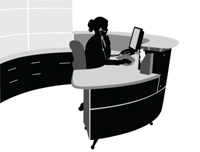 Ask most doctors, “When it comes to building your practice, who is the most important staff person?” and the answer is usually, “The receptionist.”
Ask most doctors, “When it comes to building your practice, who is the most important staff person?” and the answer is usually, “The receptionist.”
Follow that up with, “Who is the lowest paid person in your office?” and you’ll undoubtedly get the same answer. Ask a third question: “Who has the least amount of training?” Once again, you’ll hear the same reply.
Although most of us know that the first impression of our practice—usually on the telephone—is critically important, very few of us actively work on developing and improving this aspect of our practice. Instead, telephone skills training for most offices is usually overlooked—either because we assume that answering the phone is self-explanatory or because we take for granted that ineffective habits are the norm.
 Here are a few steps you can take to guarantee that your receptionist provides a consistent and accurate reflection of your practice.
Here are a few steps you can take to guarantee that your receptionist provides a consistent and accurate reflection of your practice.
• Hire the right personality. Make sure the person you hire is outgoing, cheerful and, of course, articulate. This is no place for wallflowers or soft-spoken individuals. While conducting the job interviews, remember to ask open-ended questions designed to get the candidate talking. This will give you an opportunity to carefully assess their enthusiasm, mannerisms and speech qualities.
• Pay a more competitive salary. Although I am a management consultant trained to focus on the bottom line, my best advice is to pay your receptionist more than you think you need to. You really do get what you pay for, and while you certainly do need to keep labor costs under control, this is not the place to skimp.
• Let your receptionist be a receptionist. When phone staff is given the additional tasks of checking patients in or out, handling insurance claim follow-up calls or helping patients learn to care for their contact lenses, the quality of the ensuing conversations is bound to suffer. This is particularly true when a lesser-trained person must step in to help.
• Adopt a call center model. As your practice grows, consider setting up a call center model where the phones are answered out of earshot from your waiting patients. Typically, most phones are answered at the front check-in desk—the same area where other patients are coming into the office or waiting to be seen by the doctor. When receptionists handle calls in such a busy environment, it is hard to block out distractions like approaching patients asking questions. By setting aside a private phone area, you are better lending yourself to the no multi-tasking concept—which, in turn, allows your receptionist to channel her energy and attention directly to the phone call.
• Ensure compliance. The best way to see if your new strategies are working is to test them out for yourself. Enlist the help of mystery callers and use the results of these calls to give out performance-based raises. Have a set of fixed parameters you want measured on the call such as the wait time before the call was answered, the greeting offered, whether the caller was placed on hold and whether the caller’s questions were answered. Your callers should have a checklist in front of them along with various scenarios you’ve composed. It is important to not be deceptive; receptionists should know that these calls will be forthcoming, just not when to expect them.
While scripted answers can be a useful training tool for some frequently asked questions, the truth is that there is no substitute for adequate training. It is more important to train your receptionist to provide answers that are both clinically accurate and convey your practice philosophy. Taking the time initially to properly train your receptionist will pay off in the long run.
My last piece of advice is to start calling your own office more often. The staff will get into the habit of expecting your calls and will work on perfecting their phone skills to impress you.


